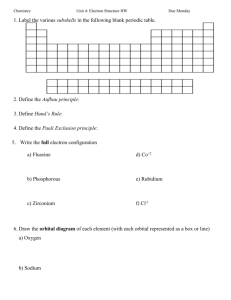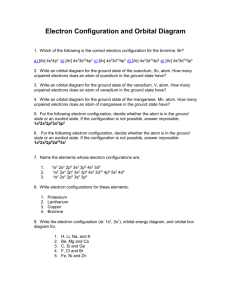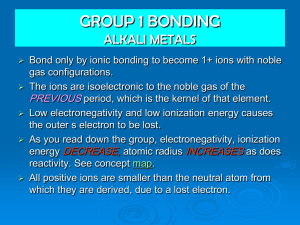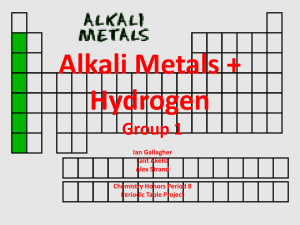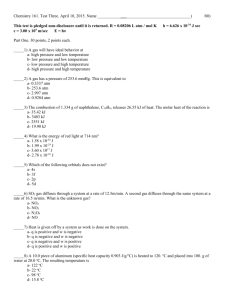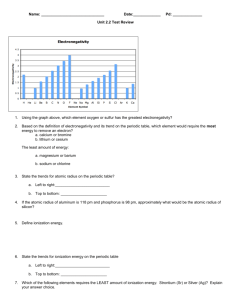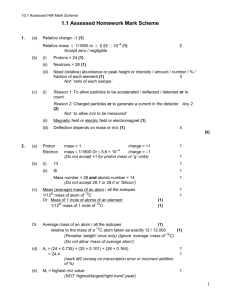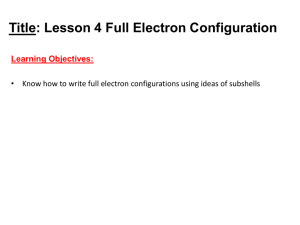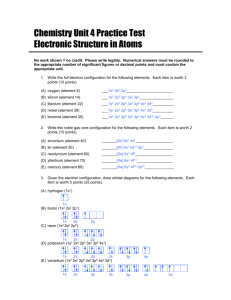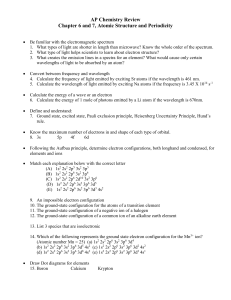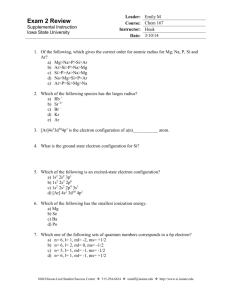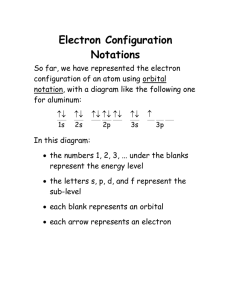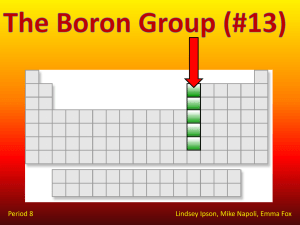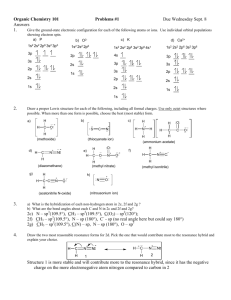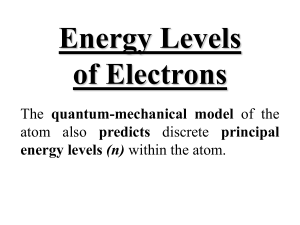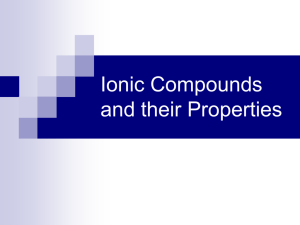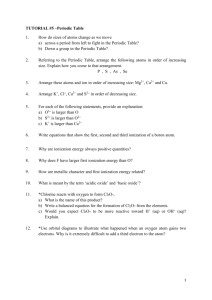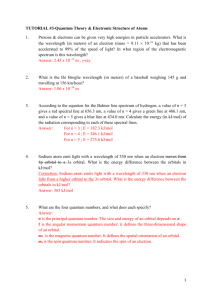1 - Berkeley City College
advertisement
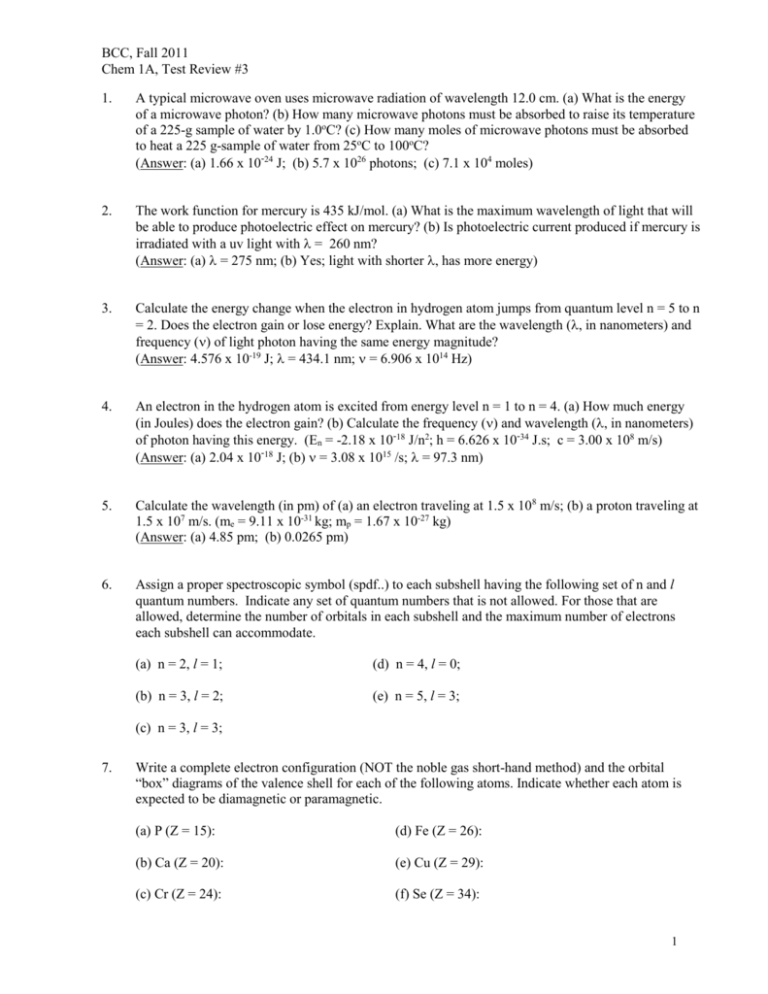
BCC, Fall 2011 Chem 1A, Test Review #3 1. A typical microwave oven uses microwave radiation of wavelength 12.0 cm. (a) What is the energy of a microwave photon? (b) How many microwave photons must be absorbed to raise its temperature of a 225-g sample of water by 1.0oC? (c) How many moles of microwave photons must be absorbed to heat a 225 g-sample of water from 25oC to 100oC? (Answer: (a) 1.66 x 10-24 J; (b) 5.7 x 1026 photons; (c) 7.1 x 104 moles) 2. The work function for mercury is 435 kJ/mol. (a) What is the maximum wavelength of light that will be able to produce photoelectric effect on mercury? (b) Is photoelectric current produced if mercury is irradiated with a uv light with = 260 nm? (Answer: (a) = 275 nm; (b) Yes; light with shorter , has more energy) 3. Calculate the energy change when the electron in hydrogen atom jumps from quantum level n = 5 to n = 2. Does the electron gain or lose energy? Explain. What are the wavelength (, in nanometers) and frequency () of light photon having the same energy magnitude? (Answer: 4.576 x 10-19 J; = 434.1 nm; = 6.906 x 1014 Hz) 4. An electron in the hydrogen atom is excited from energy level n = 1 to n = 4. (a) How much energy (in Joules) does the electron gain? (b) Calculate the frequency () and wavelength (, in nanometers) of photon having this energy. (En = -2.18 x 10-18 J/n2; h = 6.626 x 10-34 J.s; c = 3.00 x 108 m/s) (Answer: (a) 2.04 x 10-18 J; (b) = 3.08 x 1015 /s; = 97.3 nm) 5. Calculate the wavelength (in pm) of (a) an electron traveling at 1.5 x 108 m/s; (b) a proton traveling at 1.5 x 107 m/s. (me = 9.11 x 10-31 kg; mp = 1.67 x 10-27 kg) (Answer: (a) 4.85 pm; (b) 0.0265 pm) 6. Assign a proper spectroscopic symbol (spdf..) to each subshell having the following set of n and l quantum numbers. Indicate any set of quantum numbers that is not allowed. For those that are allowed, determine the number of orbitals in each subshell and the maximum number of electrons each subshell can accommodate. (a) n = 2, l = 1; (d) n = 4, l = 0; (b) n = 3, l = 2; (e) n = 5, l = 3; (c) n = 3, l = 3; 7. Write a complete electron configuration (NOT the noble gas short-hand method) and the orbital “box” diagrams of the valence shell for each of the following atoms. Indicate whether each atom is expected to be diamagnetic or paramagnetic. (a) P (Z = 15): (d) Fe (Z = 26): (b) Ca (Z = 20): (e) Cu (Z = 29): (c) Cr (Z = 24): (f) Se (Z = 34): 1 BCC, Fall 2011 Chem 1A, Test Review #3 8. In what group and period, respectively, would you find atom with the following electron configurations? Which of these atoms belongs to the transition metal group? (a) 1s2 2s2 2p6 3s2 3p1; (b) 1s2 2s2 2p6 3s2 3p6 4s1 3d10; (c) 1s2 2s2 2p6 3s2 3p6 4s2 3d10 4p4; (d) 1s2 2s2 2p6 3s2 3p6 4s2 3d10 4p6 5s2; (e) 1s2 2s2 2p6 3s2 3p6 4s1 3d5; (f) 1s2 2s2 2p6 3s2 3p6 4s2 3d10 4p6 5s2 4d5; 9. Write the electron configuration of each of the following atoms or ions using the complete spectroscopic (spdf..) notation and the noble gas short-hand notation. (a) S2- : (b) Cr3+ : (c) Fe3+: (d) Zn2+: (e) Pb2+: Using the orbital “box” diagrams, determine the above atoms or ions are diamagnetic or paramagnetic. Indicate the number of unpaired electrons present in each case? 10. (a) Explain using the concept of effective nuclear charge, the trends how atomic size varies across a period and down a group, respectively, in the periodic table. (b) Rank the elements Al, K, Mg, Na, and Rb, in order of: (i) increasing atomic size; (ii) increasing ionization energy; (iii) increasing electron affinity, and (iv) increasing reactivity. (c) Rank the elements Br, Cl, F, N, and O, in order of: (i) increasing atomic size; (ii) increasing ionization energy; (iii) increasing electron affinity, and (iv) increasing reactivity. 11. Given the following ionization energies of the second period elements: Element: Li Be B C N O F Ne I1(kJ/mol: 520 899 800 1086 1402 1314 1681 2088 (a) Explain the general trend observed for the ionization energy across period. (b) Explain the anomaly to the general trend observed between beryllium and boron and between nitrogen and oxygen. 2 BCC, Fall 2011 Chem 1A, Test Review #3 12. Consider the following ionization energies for magnesium: Mg(g) Mg+(g) + e-; I1 = 735 kJ/mol Mg+(g) Mg2+(g) + e-; I2 = 1445 kJ/mol Mg2+(g) Mg3+(g) + e-; I3 = 7730 kJ/mol (a) What is the trend in the ionization energy (I1, I2, and I3) for magnesium. (b) Explain the large increase between I2 and I3. (c) Which ion of magnesium has the greatest electron affinity? Explain. (d) Rank the three ions in order of increasing ionic radii and explain your reasoning. 13. Given the following processes and enthalpies: Processes: Ho, kJ Li(s) Li(g); 161 + Li(g) Li (g) + e ; 520 Cl2(g) 2Cl(g); 244 Cl(g) + e- Cl-(g); -349 Li(s) + ½Cl2(g) LiCl(s); -408 Calculate the lattice energy represented by the following process: Li+(g) + Cl-(g) LiCl(s). (Answer: -862 kJ) 14. Given the following processes and their enthalpies in kJ: Processes: Ho, kJ Na(s) Na(g); 108 + Na(g) Na (g); 496 Cl2(g) 2Cl(g); 242 Cl(g) + e- Cl-(g); -349 + Na (g) + Cl (g) NaBr(s); -788 Calculate the enthalpy change, Hrxn, for the following reaction: Na(s) + ½Cl2(g) NaCl(s) (Answer: -412 kJ) 15. Using bond energy given in Table 8-4, calculate the enthalpy change for the following reactions and indicate whether it is exothermic or endothermic. (a) CH3CH2Cl(g) H2C═CH2(g) + HCl(g); (Answer: 58 kJ) (b) C2H2(g) + HCl(g) H2C═CHCl(g); (Answer: 3 BCC, Fall 2011 Chem 1A, Test Review #3 16. (a) Write the Lewis structure for the following molecules. Indicate whether they obey the octet rule. If not, suggest whether they have an incomplete octet of an expanded octet. (b) Use the VSEPR method to propose the molecular geometry and predict the molecules are polar or nonpolar. (c) Name the type of hybridization expected on the central atom in each molecule. (a) BeF2 (b) GeF2 (c) XeF2 (d) XeF4 17. Draw all resonance Lewis structures for N2O molecule. Indicate the most favored structure and explain your reasoning. Predict whether the molecule is polar or nonpolar. 18. Refer to the following structure and answer questions (a) - (g): H H HC1―C2═C3C4≡C5H H H (a) The total number of -bonds = ______; the number of -bonds = _____. (b) Give the predicted bond angles at: C1: ____; C3: ____; and C5: ____. (c) Which CC bond is the longest? __________ (d) Which CC bond has the highest bond energy? ___________ (e) What type of hybridization (if any) occurs at: C1: ______; C2:_____; C4: _____? (f) What is the geometrical orientation of bonds (or bonded atoms) around: (i) C1: _______________; (ii) C2 :________________; (iii) C4 : ___________; 19. Use the VSEPR method to determine the electron-pair orientation around the central atom in each molecule and predict the molecular shape. Propose orbital hybridization on the central atom in each molecule and predict whether each molecule is polar or nonpolar. (a) ClF3 20. (b) SF4 (c) BrF5 Draw valence-shell molecular orbital energy diagrams for the following molecular species: CO, NO, O2, O2-, and O22-. Determine the bond order in each molecule or molecular ion, and indicate whether it is diamagnetic or paramagnetic? [You may draw only the valence shell energy diagrams.] 4
